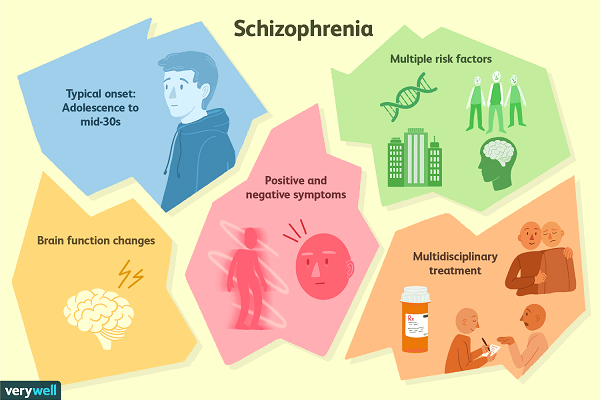Active listening for couples
5 Keys to Active Listening for Couples
By: Couples Counseling Staff
Active listening is one of those terms that we often hear but what does it really mean? According to experts in the field of communication, active listening means that you possess and have developed a specific kind of communication skill that allows you to fully hear what another person is trying to say.
We know from experience as relationship counseling professionals that the ability for a couple to communicate in a meaningful way is vital to long term relational success.
What follows are five keys to active listening for couples. Some of these tips may seem obvious while others will require you to pause and think. Read them all so that you can more fully absorb their deeper meaning.
When you are done, reflect upon some of your past conversations with your mate and identify the areas that need improvement. This is a common homework assignment that we give couples here at the Center.
Are you ready? Let’s jump right in!
1. Let your partner speakThis simply means that you should refrain from arguing your case until your partner finishes stating her or his position. Resist the urge to interrupt and cut off your mate mid-sentence.
Finally, if you are aware that you historically take more time talking than your partner, this is a good sign that you need to talk less and encourage your significant other to talk more.
2. Put yourself in your partner’s shoesIf you are unmotivated to be a good listener, you are probably being sidetracked. During times of conflict, you should enter the conversation with specific goals of what you would like to learn from your mate – and not your talking points.
Try to focus on your partner’s needs and feelings. This point also means allowing yourself to be in your partner’s shoes for a moment and trying to see a given situation from their viewpoint.
3. Don’t jump to conclusions
Even when folks are trying to listen, they sometimes assume that they know what their mate will say before the words can escape their mouth. If you do this – you need to make adjustments. Jumping to a conclusion means that you have entered the conversation with a pre-existing belief.
One approach is to simply take a deep breath and clear your mind of any thoughts. You may need to do this several times in order to purge this mental material from your consciousness.
4. Ask questionsTo really understand where your mate is coming from, you should ask clarifying questions. Again – this means allowing your partner to speak first. Then, when there is a lull in the dialogue, feel free to ask something that you need clarification on.
Avoid asking questions disguised as accusations. Instead, focus on knowledge that you truly need in order to better understand your partner’s position.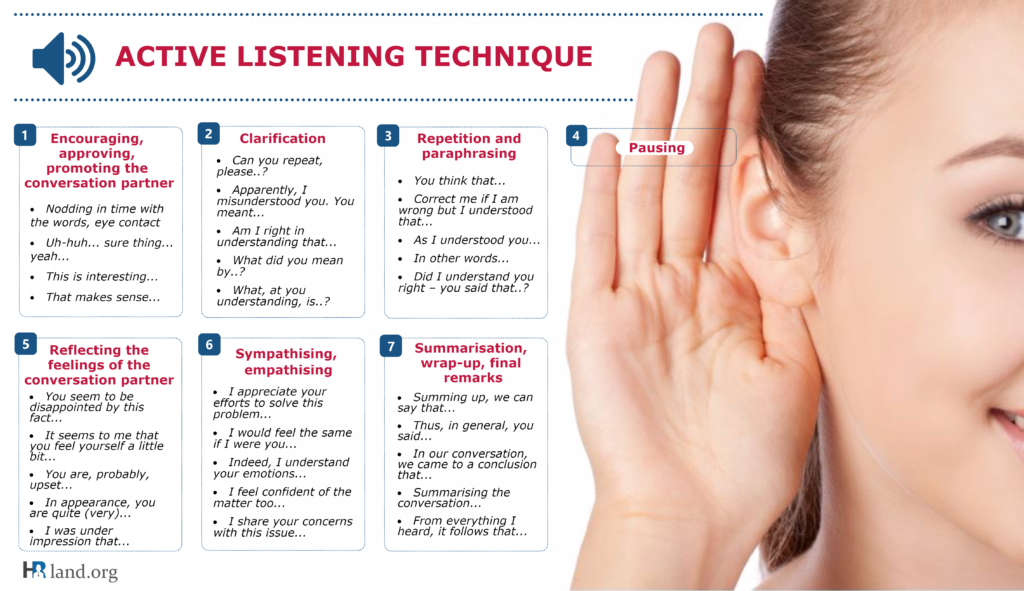
5. Paraphrase what your partner says
Paraphrasing simply means confirming what you have heard through verbal summary. Communicate back to your mate the main points she/he has made objectively. Be aware there is a big difference between paraphrasing and parroting. In other words, don’t engage in a verbatim account or take on a litigious tone.
A good way to do this is to preface a paraphrase with a question. Example: It sounds like my having to work overtime last night really made you mad?
Summing Things UpOne of the main reasons couples find themselves in therapy can be traced to a breakdown in communications. When left unchecked, these breakdowns can cause a rift and lead to a relational collapse.
Some couples find it useful to engage in meaningful conversation because it always seems to turn into a “fight”. If this is happening in your situation, we recommend you examine our suggestions for fair fighting.
One resource you might want to think about if you are looking to improve your communication skills is The Lost Art of Listening by Dr. Michael P. Nichols. Inside, you will find practical tips and insight about how you and your partner can stop the cycle of constant bickering and fighting.
Nichol’s book also does a good job of providing examples and techniques to move past communications hurdles and create greater intimacy in the relationship.
Some couples find it helpful to work with a relationship counselor as a way of finding new approaches to dialogue. Depending upon the dynamics, one on one counseling with a therapist can also be helpful.
If you live in Chicago and want to know more about our relationship counseling services, be sure to stop by our services page.
We hope you found the suggestions made here useful. Please be sure to like Couples Counseling Center on Facebook, Circle Us on Google Plus and Pin on Pinterest!
How to Listen Better in a Relationship
Becoming a better listener in your relationship may involve skills like empathizing, serving as a mirror, and paraphrasing. But it’s important to be an effective speaker, too.
But it’s important to be an effective speaker, too.
Active listening in relationships can be a game changer. But, what is a good listener and how can you connect better to your partner?
The foundation of successful communication is being able to truly listen to each other, without “constructing a counter argument in your head,” says Michael Batshaw, LCSW, a licensed clinical social worker and relationship expert.
In other words, the first step to being a better listener to your partner is to actually listen to learn from them, not to respond to them.
“It’s important to recognize that there are two parts to any conversation,” says Terri Orbuch, PhD, a psychologist who specializes in couples. “There’s the person doing the talking and the person who’s trying to actively listen.” If you’re working on improving communication in your relationship, you may want to work at being good at both.
Body language counts
To listen better in a relationship, you may want to start by identifying all the processes involved in communication.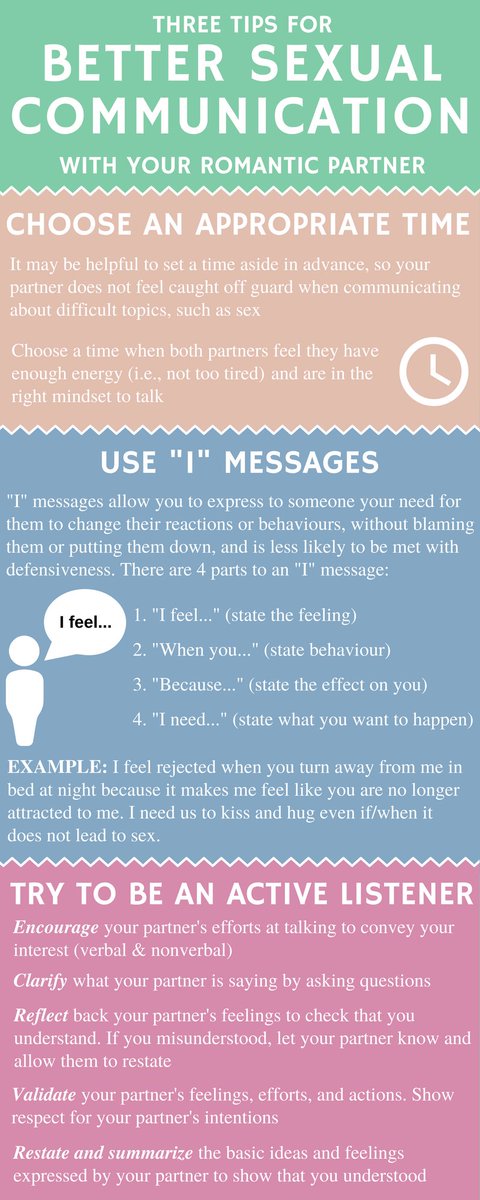
For example, Orbuch explains you also listen with your body. How you move, where you look, and how you sit or stand may indicate how good of a listener you are.
If you want your partner to feel you’re actively listening to them, consider:
- holding eye contact
- leaning forward
- avoiding your phone and other distractions
- engaging in facial expressions that are reassuring
Focus is key
The secret to being a good listener is to focus on what the other person is saying to you. It seems simple but, for some people, it may be easier said than done.
You may want to start by eliminating all the distractions “that may influence the ability to focus on your partner,” says Orbuch. That includes turning off the computer and TV and muting your cell phone.
Debaters aren’t invited
Engagement isn’t only about replying or building your own case in reference to what your partner is saying.
An important active listening skill is to pause the debater in your head and engage the listener.
“Debaters listen to prove that they’re right and the other is wrong,” says Susan Heitler, PhD, a Denver clinical psychologist and author of the book “The Power of Two: Secrets of a Strong & Loving Marriage.”
How do you know if you’re a debater or a good listener? The first one will tend to start their reply with a, “Yes, but…” or “I know, but…,” says Heitler. You might even express a “silent but,” by dismissing the conversation, she adds.
Using the silent treatment or indifference, or any other toxic behaviors, may also be a form of “silent but.”
“The listener has to hold back their own emotional reactions and interpretations, and really try to get the essence of what the speaker is putting out,” explains Robert Solley, PhD, a San Francisco clinical psychologist specializing in couples therapy.
Paraphrasing goes a long way
Summarizing what your partner is saying ensures that you’re hearing “what your partner intends for you to hear,” Orbuch says.
But this is more than one partner saying, “I think the house is a mess,” and the other partner saying, “You think the house is a mess.”
As Heitler puts it, “no one wants to be married to a parrot.”
Paraphrasing might also involve adding your interpretation of what was said and checking with your partner if that’s accurate.
Getting more information about the points you’re not clear about also sends the message that you were actively listening and are now considering what was said.
Heitler also suggests telling your partner what you agree with and what your own thoughts are by using the words “and” or “and at the same time.”
Making assumptions might not help
Orbuch calls this “perception checking.” In addition to understanding what your partner said, you want to make sure you understand how they feel.
You might think your partner is angry with you, for example, when they’re really excited or frustrated, Orbuch explained.
Consider asking something like, “Did I hear that you’re feeling XYZ with me because of how I behaved at the holiday party?” That gives your speaker the chance to clarify the emotional aspect of the conversation.
Empathizing for the win
“Recognizing the intention is far more effective than techniques for active listening,” says Batshaw. “The couples who stay the most stuck refuse to fully engage in the other person’s perspective.”
That’s when empathy comes in. The ability to put yourself in someone else’s shoes and understand what they’re going through, even if it’s not your experience, is a powerful connector.
In the end, the goal of being a good listener is to connect genuinely with the other person. For that, you may need to go beyond just hearing what they say and make an effort to understand their experience and perspective.
Picking the right time to talk
For communication to be effective, context needs to be taken into account.
“Timing is everything,” says Orbuch.
While there’s no “perfect time” to talk, you may want to consider not bringing up important topics when either of you is engaged in other tasks that require attention, or when one of you is exhausted or having a bad day.
Checking with your partner to see if it’s a good time to talk, and respecting what they tell you, may be the first step toward having an effective conversation.
Sticking to one issue
You may have a few things to talk about, but if they’re unrelated, you may want to approach them one by one.
Orbuch says it’s important to avoid “kitchen sinking,” which is bringing up all your problems or concerns at once.
Focusing on one topic means “your partner can clearly respond to an issue and figure out how to change,” Orbuch notes. Kitchen sinking, however, “boxes your partner in and they don’t know where to go.”
Validating your partner’s feelings
Whether you’re responding to your partner after actively listening or you want to bring up the conversation, it’s important to validate what your partner is thinking and feeling.
This may look like acknowledging you understand what they’re going through even if you don’t agree or can’t relate.
The next step might be to ask more questions about the possible reasons why they feel this way and the way you can support them. You may also want to express how you think or feel about the same incident, and try to find some common ground to connect through.
You may also want to express how you think or feel about the same incident, and try to find some common ground to connect through.
Using “I” statements
When a speaker uses the word “you,” it may push the listener toward getting defensive and stop listening.
For example, instead of saying, “You’re so disrespectful to me,” consider saying, “I feel uncomfortable when you do that.”
Using X, Y, and Z statements
This means pointing out a behavior (X), in a given situation (Y), and saying how it makes you feel (Z).
When you do this in a conversation, your partner can identify a specific scenario, understand how you feel about it, and know what they need to do.
For example, you may say to your partner, “When you don’t say ‘hi’ to my mom whenever she comes over, it makes me feel angry and disappointed.” They now know that saying “hi” to your mom is important to you.
Effective listening and other communicating skills require practice. How to listen better in a relationship starts with engaging your whole body, limiting distractions, paraphrasing, and empathizing with your partner.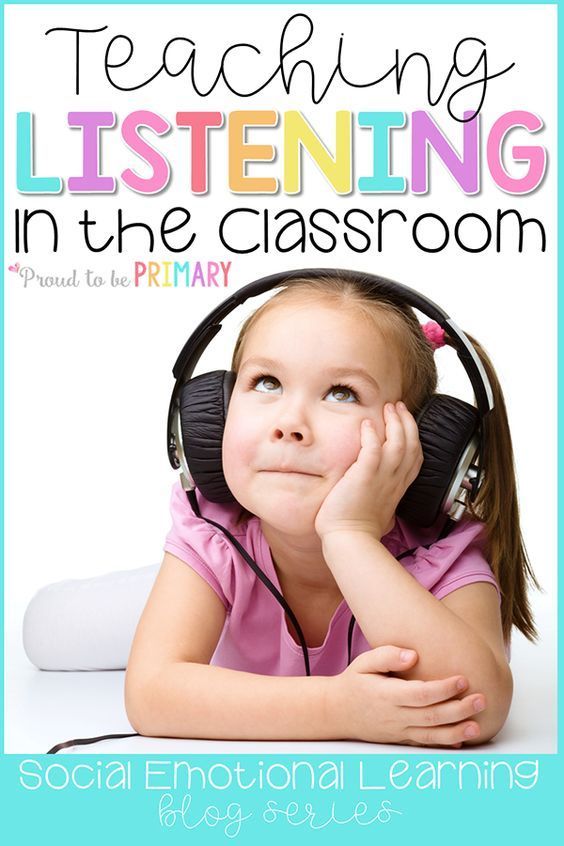
Learning how to become a good speaker may also help you improve communication so you can work on a lasting bond.
Active listening: techniques, techniques and examples
Active listening is a useful skill for establishing deep contact with the interlocutor, effectively finding a joint solution to issues. This is a complex communication skill, sometimes puzzling. For many, listening is the passive acceptance of information from other people.
The attitude to contact with the interlocutor was accurately described by the American satirist Mark Twain: “Most conversations are a monologue in the presence of witnesses.” But this position becomes a trap, falling into which we misinterpret the meaning of the conversation. The dialogue ends with misunderstanding, unpleasant sensations, problems in relationships. How to avoid it? 9Ol000 remarks on the conversation
Active listening - what is it
When talking to someone, we are often not mentally involved in the process. Our brain is busy with abstract processes:
Our brain is busy with abstract processes:
- strong emotional experiences;
- thinking about personal problems;
- subjective assessment of the interlocutor.
These are familiar communication scenarios that seem normal. We listen, but we don't hear! This expresses a passive approach to contact with people, causing many difficulties. Active listening is the exact opposite of normal communication. This is a process of conscious interaction, in which attention is focused on the thoughts and feelings of the interlocutor. There are no background noises in the head, extraneous processes (for example, appearance assessment) too.
We are absorbed in the here and now, so we direct the conversation in the right direction, get a lot of useful information. It will not be distorted by our subjective mental filters. In addition, having learned the technique of active listening, you can send signals of interest to the interlocutor. They will become a solid foundation for fruitful relationships in the future.
Active Listening Technique: Basic Principles
No matter how eloquent a speaker is, we can only get the most out of the information presented if we learn to listen correctly. This is precisely the purpose of active listening. The main factors contributing to its development:
- Acceptance of the interlocutor as he is. It is a careful control of emotions and subjective assessments, which can greatly interfere with understanding what is heard.
- Eye contact at eye level. It consists in keeping from the temptation to look at foreign objects or clothes of the interlocutor. It's better to look into the eyes.
- Asking questions. It is an appropriate clarification of meanings, which serves as a confirmation of sincere interest in the subject of conversation.
The technique of active listening is used in psychology. Psychologists describe it as the perception of information "with the whole body." It has been scientifically proven that active listening helps to better understand the condition of people. When communicating with clients, specialists use participatory dialogue techniques that help to more accurately determine their condition. Deep immersion, establishing trust, analyzing the condition of patients provide effective assistance. These points serve to explain the second name of active listening - empathic.
When communicating with clients, specialists use participatory dialogue techniques that help to more accurately determine their condition. Deep immersion, establishing trust, analyzing the condition of patients provide effective assistance. These points serve to explain the second name of active listening - empathic.
The book "The Miracles of Active Listening" will help you to study in depth the technique of establishing contact of active listening and argumentation. The author is a well-known Russian scientist, popularizer of science, honored psychologist Yulia Borisovna Gippenreiter. She was the first to introduce the concept of active listening into our culture, describing what it includes, how it improves the quality of life many times over.
Active Listening Techniques
There are many ways to turn passive listening into active listening. In addition to the above basic factors, there are three more techniques that are also worth familiarizing yourself with. They help you quickly understand the process.
They help you quickly understand the process.
| Active Listening Technique | Features |
|---|---|
| Echo | It consists in repeating the last words of the partner, but with an interrogative intonation. This is the right moment to clarify and demonstrate the importance of the information coming from the interlocutor. Emphasis on the importance of the individual. |
| Interpretation | It implies making assumptions about the goals and reasons for such a position of the interlocutor in the dialogue. Often begins with the phrase "I assume that you wanted to achieve the above ...". Allows you to demonstrate sincere interest in the opinion of another person and clarify the details. |
| Paraphrasing | Represents a brief repetition of what was said. The beginning of the sentence is the phrase: "If I understood correctly, you meant ...". Allows you to show interest and find out the nuances. |
Thus, active listening is a technology that almost always includes two components:
- clarification of the true meanings of the conversation;
- manifestation of signs confirming the value of dialogue.
Feeling his own importance and genuine interest in the conversation, the interlocutor becomes more open. This contributes to fruitful mutually beneficial communication, the emergence of trust, strong relationships. Such results are valuable in any area of life (communication with family members and friends, cooperation with partners and colleagues).
Empathy is a powerful amplifier of all active listening techniques and techniques. People who know how to feel the state of others are able to quickly establish positive contact, use any technique appropriately and delicately. Therefore, to increase the effectiveness of the application of the selected techniques (from the list below), it is important to work on the level of empathy.
Pause
After the opponent has finished his story, just keep silent for a couple of minutes. Such a pause will allow you to better digest what you heard, to separate emotions from the true subject of the conversation. Such a break will allow a speaking person to take a break, remember something important and say it. Often the use of such a technique helps him to open up even deeper after a short respite.
Please clarify
Sometimes the interlocutor misses many important and interesting details in his story. Showing attention to them is a great way to emphasize the value of information coming from him and sincere interest in it. Also, this technique of active listening will help to avoid omissions and strengthen trusting relationships, to form in the imagination a complete picture of the topic of conversation.
We develop a thought
Sometimes a person deviates from the essence of the conversation or cannot find the exact words to continue the topic. In this case, active listening to develop the main idea of the conversation will be an excellent assistant. It is necessary to return the speaker to the main thread of the dialogue and delicately develop it together with him.
In this case, active listening to develop the main idea of the conversation will be an excellent assistant. It is necessary to return the speaker to the main thread of the dialogue and delicately develop it together with him.
Making a message
A technique that helps to give delicate feedback. Depending on situational features, it can be implemented in two versions:
- Perception report. The listener shares his impressions of the partner or directly from the conversation. This approach is especially valuable for strengthening ties between children and parents, spouses.
- Message about self-perception. In this case, the listener describes his internal state after the conversation, the changes that have occurred.
Whatever the message is (positive or negative), it is important to express it in a calm, friendly tone. Rudeness, aggressive accusations and other negative forms of expressing feelings instantly nullify the effectiveness of active listening.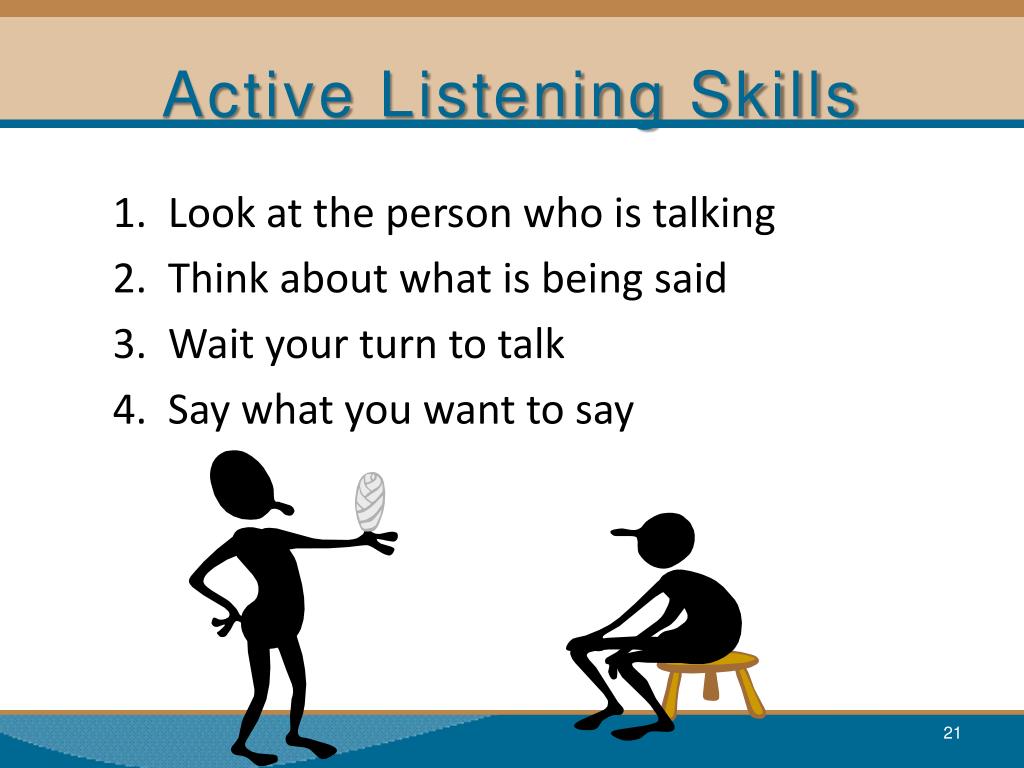
Talking about emotions
This active listening technique involves open communication about the internal state of the interlocutor with an expression of a desire to support or help. For example, when the speaker gets very upset during the conversation, this technique is implemented by the phrase "I see how hard and painful it is for you to talk about this ...". Helps to demonstrate a sensitive attitude, which often becomes the basis of a trusting relationship.
Making comments about the conversation
Reception allows you to express the final result of the successful (or vice versa) development of the conversation. It is a comment about reaching a common understanding of the topic. If it has not been reached, the remark may reflect a problem of misunderstanding. This is how the next stage of its effective resolution is formed (after the exact formulation of the subject of the dispute or reticence).
Active listening techniques
Active listening techniques are different from techniques. They are based on the development of the skill to understand the meaning of the conversation deeper than words convey. It was mentioned above that the ability to empathize plays a huge role in the successful implementation of active listening and argumentation techniques. It is she who underlies modern methods, manifesting itself at three basic levels:
They are based on the development of the skill to understand the meaning of the conversation deeper than words convey. It was mentioned above that the ability to empathize plays a huge role in the successful implementation of active listening and argumentation techniques. It is she who underlies modern methods, manifesting itself at three basic levels:
- Empathy. It consists in the manifestation of the same emotions that take possession of the opponent. For example, when he cries, the listener also has tears in his eyes.
- Sympathy. It manifests itself in the form of an offer to help the interlocutor when he finds himself in a difficult situation.
- Sympathy. Represents a persistent supportive, benevolent attitude towards the speaker.
The use of methods is a way to penetrate into the inner world of another person, when the conversation is not limited to words. It becomes capacious and informative, but also requires large psycho-emotional costs. Although they are fully paid off by the subsequent formation of strong, trusting relationships.
Although they are fully paid off by the subsequent formation of strong, trusting relationships.
The basic methods of active listening are formulated by the leader and creator of humanistic psychology, Carl Rance Rogers. They are as follows:
- Sincere, deep participation in the inner world of the speaking person.
- Open expression of feelings.
- Absence of characteristic roles limited to formal actions.
- Stable fulfillment of obligations towards the interlocutor.
A special place is given to empathic silence. This method involves not commenting to give the other person a chance to speak from the heart. But silence is accompanied by non-verbal signals that make the interlocutor feel interested in his situation and personality as a whole. They include head shakes, gestures, facial expressions, appropriately used in the process of communication.
Active Listening Exercises
This useful skill is developed in pairs.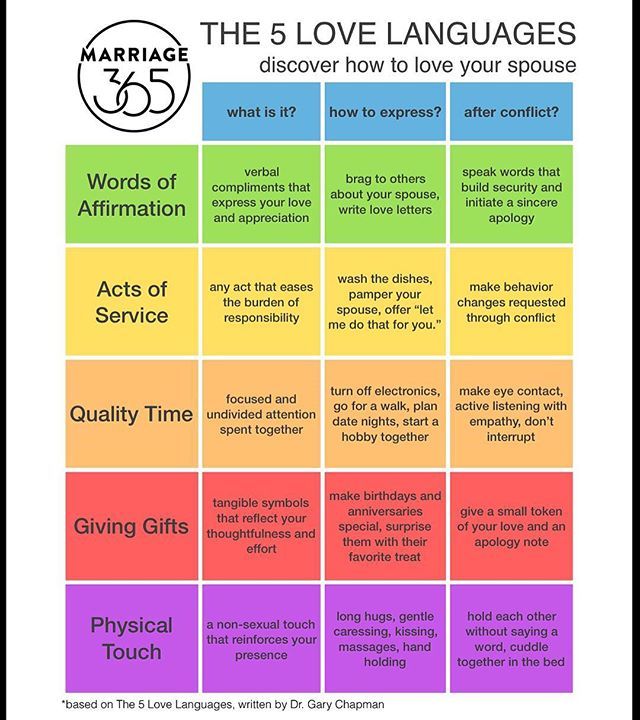 One of the participants plays the role of the listener, and the second - the speaker. Then they change places. On average, the duration of the exercises takes 30-45 minutes. During this time, the following stages are implemented:
One of the participants plays the role of the listener, and the second - the speaker. Then they change places. On average, the duration of the exercises takes 30-45 minutes. During this time, the following stages are implemented:
- During the first 5 minutes, one of the interlocutors talks about personal difficulties, indicating the probable causes of their occurrence. The partner interacts with him using active listening techniques.
- A couple of minutes after the first stage is given to the speaker's statements about what specifically in the behavior of the listener helped or hindered opening up in the conversation.
- After this 5 minutes, the speaker continues to share his thoughts. Now about what character traits help him cope with the difficulties mentioned. The task of his partner is to continue to use active listening, taking into account the errors identified in the second stage.
- For the next 5 minutes, the listener summarizes what was learned from the previous two stories by the speaking partner.
 He only nods signs signaling agreement with him or vice versa. If incorrect interpretations are identified, the former listener corrects them in such a way that the interlocutor agrees with him.
He only nods signs signaling agreement with him or vice versa. If incorrect interpretations are identified, the former listener corrects them in such a way that the interlocutor agrees with him.
The end of the first round of studies comes after the speaker from the pair can formulate exactly what exactly he was understood correctly, and where an erroneous interpretation occurred. After that, the partners switch roles.
Examples of active listening in practice
Examples of active listening are found everywhere. At work, they are reflected in the form of improved relationships with the team. The family helps to overcome crisis and conflict periods. At the same time, in any interaction, active listening manifests itself in two planes - non-verbal and verbal. The first involves facial expressions and gestures that make contact deeper. In the second, these are phrases correctly built in accordance with the chosen technique. For example:
For example:
- “What exactly do you mean?”
- "I understand you perfectly!"
- "That's really interesting!"
Also here is the question of how it happened what the interlocutor is talking about.
Conclusion
Speech is the main way of communication between people, which is often implemented in a disparaging manner. During a conversation, listeners are distracted from the essence of the conversation, do not perceive the information provided, or interpret it incorrectly. This then negatively affects relationships. The technique of active listening helps to eliminate these difficulties, so that interaction with people brings satisfaction and opens up new opportunities for development.
Active listening - methods of active listening in psychology
One well-known parable says that a person is given two ears and one mouth, which means people should speak less than listen to each other. It is important for a person to be heard, understood, and listening more - many things and secrets are comprehended. Active listening is a method that has gained credibility among psychologists because of its effectiveness and simplicity.
It is important for a person to be heard, understood, and listening more - many things and secrets are comprehended. Active listening is a method that has gained credibility among psychologists because of its effectiveness and simplicity.
What is active listening?
Active or empathic listening is a technique that was introduced into psychotherapy by an American psychotherapist, the creator of humanistic psychology - Carl Rogers. Active listening is a tool that helps to hear, understand the feelings, emotions of the interlocutor, direct the conversation in depth and help a person experience and transform his state. In Russia, the methodology was developed and supplemented with various nuances thanks to the child psychologist Yu. Gippenreiter.
Empathic listening in psychology
Active listening techniques in psychology help to harmoniously build a conversation, discover the client's problem area and select the appropriate individual therapy. In working with children, this is the best method, because a small child still does not quite identify and knows his feelings. During empathic listening, the psychotherapist abstracts from his problems, emotional experiences and is completely focused on the patient.
During empathic listening, the psychotherapist abstracts from his problems, emotional experiences and is completely focused on the patient.
Active listening - types
Types of active listening are conventionally divided into male and female. Features of each type:
- Men's active listening - involves reflection and is used in business circles, negotiations in business. The information received from the interlocutor is carefully analyzed from different angles, many clarifying questions are asked, since men are focused on the result. Reasonable criticism is also appropriate here.
- Women's Active Listening . Due to the natural emotionality and greater experience of feelings, women are more open and have greater empathy: to be with the interlocutor together, to be involved with him in his problem. Empathy cannot be faked - it is felt by the other person and gives him the confidence to open up.
 Women's listening uses paraphrase techniques, an emphasis on spoken feelings and emotions.
Women's listening uses paraphrase techniques, an emphasis on spoken feelings and emotions.
Technique of active listening
Active listening is a technique and at the same time a process of maximum concentration on another person, when all the subtleties and nuances in a conversation are taken into account: observation of voice, intonation, facial expressions, gestures and sudden pauses. The main components of active listening technique:
- Neutrality . Avoidance of assessments, criticism, condemnation. Acceptance and respect for the person as they are.
- Kindness . A calm state and attitude towards the interlocutor, encouraging him to continue talking about himself, the problem - contribute to relaxation and trust.
- Sincere interest . One of the most important influence tools in the active listening technique, it helps a person to open up more fully and clarify the problem situation
Active listening techniques
Active listening techniques are multifunctional and varied. In classical psychology, there are 5 main active listening techniques:
In classical psychology, there are 5 main active listening techniques:
- Pause . It is important for a person to speak out to the end and pauses are necessary in a conversation. This does not mean that we must be silent all the time: assent (“yes”, “yep”), nodding the head are signals for a person that they are listening to him.
- Refinement of . In case of unclear points, clarifying questions are used to avoid thinking out the situation and better understand the interlocutor or client.
- Paraphrase . The method when what is heard is retold to the speaker in a short form and allows the interlocutor to confirm that “yes, everything is so”, or to clarify and clarify important points.
- Echo statement (repeat) - "return" of phrases to the interlocutor in unchanged form - the person understands that he is being listened to attentively (do not abuse this method in a conversation).
- Reflection of feelings .
 Phrases are used that correspond to the person's experience: "You are upset ...", "At that moment you were very hurt / joyful / sad."
Phrases are used that correspond to the person's experience: "You are upset ...", "At that moment you were very hurt / joyful / sad."
Rules for Active Listening
The principles of active listening include important elements without which this technique does not work:
- the interlocutor must not be interrupted;
- the question asked implies an answer to it, it is not recommended to answer or help with the answer, the interlocutor must answer the question himself - you must pause;
- visual contact throughout the conversation;
- feedback is important: support, a nod of the head;
- when experiencing aggressive, negative feelings by a person, it is important to let him throw them out to the end until he calms down.
Active listening exercises
Empathic listening techniques are practiced in psychological trainings, in groups. The purpose of the exercises is to learn to hear the other, to highlight problem areas that you can work with. The trainer divides the groups into pairs or threes and gives tasks-exercises that may vary:
The trainer divides the groups into pairs or threes and gives tasks-exercises that may vary:
- Active attentive listening exercise . The trainer gives different printed articles to three members of the group, marks 3 minutes, during which the material is simultaneously read by three members. The task for the readers is to hear what the other two are reading, the other members of the group should also hear and understand what all the articles are about.
- Exercise on the ability to detect sincerity or pretense in the words of the interlocutor . The coach distributes cards with phrases written on them. The task of the participants is to read their phrase in turn and, without thinking twice, continue the story from themselves, develop the idea. The rest of the participants listen carefully and observe whether the person is sincere or not. If the statements were sincere, then others silently raise their hand that they agree, if not, the participant is invited to pull out the card again and try again.
 The phrases on the card can be as follows:
The phrases on the card can be as follows:
- when they yell at me, I'm ready ...
- sometimes I tend to be cowardly, recently I….
- I have flaws...
- I like myself…
- annoys me in people...
- blank card (sincerely say about yourself what comes to mind at the moment).
The Miracles of Active Listening
Empathic listening is a technique that can work wonders. Active listening technology is easy to use and requires conscious directing of attention in the beginning. When using the method in the family, amazing things happen:
- year-long conflicts disappear;
- sincere and deep contact is formed between parents and children;
- an atmosphere of warmth and acceptance by family members reigns in the house.
Active listening - books
Active and passive listening - both methods are considered effective in psychotherapy and complement each other. For beginner psychologists and anyone who wants to understand people, to establish sincere friendships, the following books will be useful:
For beginner psychologists and anyone who wants to understand people, to establish sincere friendships, the following books will be useful:
- “Learn to listen” by M. Moskvin . In her book, a famous radio host tells stories and talks about the importance of listening to your interlocutor.
- “The ability to listen. The Key Skill of a Manager Bernard Ferrari . The abstract states that 90% of work and family problems can be solved through active listening.
- "The Miracles of Active Listening" J. Gippenreiter. Learning to hear and listen to your loved ones is the key to harmonious relationships in the family.
- “Listening cannot be ordered. An Alternative to Hard Management Ed. Shane . Effective communication is impossible without observing three rules: talk less, skillfully ask questions, express gratitude to the interlocutor.
- "The art of speaking and listening" M. Adler . The book deals with communication issues.
 Listening is an important aspect of human interaction. The book provides valuable advice and basic techniques for active listening.
Listening is an important aspect of human interaction. The book provides valuable advice and basic techniques for active listening.
Related articles:







